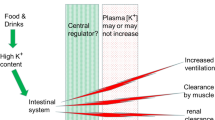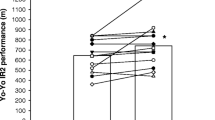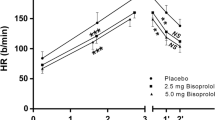Summary
Various publications have described a beta2-receptor regulated potassium transport system in the cellular membrane of human skeletal muscle. To examine the suggestion that serum potassium alterations are among the causes of premature muscular fatigue during physical exercise under pharmacological blockade of Β-receptors, we have compared the influence of sustained blockade with a beta1-selective blocker and a non-selective beta-blocker on the levels of serum potassium before, during and after a physical exercise test.
63 healthy physical education students received in random order and under double blind conditions either 100 mg Metoprolol (Β1-selective) or 80 mg Propranolol (non-selective), or placebo daily for 3 months. Serum potassium was measured before, during (at 150 Watt and at the end of exercise) and after a bicycle exercise with a stepwise increase in work loads. After three months of beta-blocker treatment serum potassium levels during exercise were significantly higher than in control subjects receiving the placebo, and it took longer for the serum potassium levels to return to the resting level in the beta-blocker treated subjects. At rest, however, the levels were not found to be statistically different. In the subjects receiving Propranolol the post-exercise serum potassium levels were higher than in the subjects receiving Metoprolol. Three days after cessation of the medication these differences were no longer perceptible.
Our findings confirm the existence of a beta-receptor regulated potassium transport system in human skeletal muscle and indicate that the transmembranous potassium transport in human skeletal muscle is predominantly regulated via beta2-receptors, although beta1-receptors seem also to be involved. The registered differences in serum potassium levels possibly contribute to the unequal impairment of physical performance capacity under beta1- as opposed to non-selective beta-blockade.
Similar content being viewed by others
References
Carlsson E, Fellenius E, Lundborg P, Svensson E (1978) Β-adrenoceptor blockers, plasma-potassium, and exercise. Lancet II:424–425
Clausen T, Flatman JA (1977) The effect of catecholamines on Na-K transport and membrane potential in rat soleus muscle. J Physiol 270:383–414
Clausen T, Flatman JA (1980) Β2-adrenoceptors mediate the stimulating effect of adrenaline on active electrogenic Na-K transport in rat soleus muscle. Br J Pharmacol 68:749–755
Epstein SE, Robinson BF, Khala RL, Braunwald E (1965) Effect of beta-adrenergic blockade on the cardiac response to maximal and submaximal exercise in man. J Clin Invest 44:1745–1753
Fellenius E (1983) Muscle fatigue and beta-blockers — a review. Int J Sports Med 4:1–8
Franz IW, Lohmann FW (1979) Der Einflu\ einer chronischen sog. kardioselektiven und nichtkardioselektiven Beta-Re-zeptoren-Blockade auf den Blutdruck, die Sauerstoffaufnahme und den Kohlenhydratstoffwechsel. Z Kardiol 68:503–509
Frisk-Holmberg M, Jorfeld L, Juhlin-Dannfelt A (1981) Metabolic effects in muscle during antihypertensive therapy with beta1- and beta1/beta2-adrenoceptor blockers. Clin Pharmacol Ther 30:611–618
Frisk-Holmberg M, Jorfeld L, Juhlin-Dannfelt A, Karlsson J (1976) Effect of long-term beta-blocking treatment on muscle metabolism in hypertensive man. Acta Physiol Scand [Suppl] 480:90
Furberg C, Schmalensee GV (1968) Beta-adrenergic blockade and central circulation during exercise in sitting position in healthy subjects. Acta Physiol Scand 73:435–446
Gorski J, Pietrzyk K (1982) The effect of beta-adrenergic blockade on intramuscular glycogen mobilization during exercise in the rat. Eur J Appl Physiol 48:201–205
Hohorst HJ (1962) L-(+)-Lactat, Bestimmung mit Lactatdehydrogenase und DPN. In: Bergmeyer HU (ed) Methoden der enzymatischen Analyse. Verlag Chemie, Weinheim
Kindermann W, Scheerer W, Salas-Fraire O, Biro G, Wölfing A (1984) Verhalten der körperlichen LeistungsfÄhigkeit und des Metabolismus unter akuter Beta1- und Beta1/2-Blockade. Z Kardiol 73:380–387
Kindermann W, Schmitt WM, Biro G, Schnabel A (1981) Metabolismus und hormonelles Verhalten bei Körperarbeit unter akuter Beta1-Sympathikolyse. Z Kardiol 70:406–412
Kindermann W, Schnabel A (1983) Beeinflussung der körperlichen LeistungsfÄhigkeit durch Beta-Blockade. Herz Kreisl 6:286–291
Lohmann FW (1981) Die Beeinflussung des Stoffwechsels durch Beta-Rezeptoren-Blocker. Klin Wochenschr 59:49–57
Lundborg P, åström H, Bengtsson C, Fellenius E, von Schenk H, Svensson L, Smith U (1981) Effect of beta-blockade on exercise performance and metabolism. Clin Sci 61:229–305
Mittenecker E (1958) Planung und statistische Auswertung von Experimenten. Deuticke, Wien
Petch MC, McKay R, Bethune DW (1979) Biochemical effects of beta2 adrenergic blockade in patients undergoing cardiopulmonary bypass [abstract]. Br Heart J 42:240
Simon G, Dickhuth HH, Lindscheidt G, Kindermann W, Keul J (1979) HÄmodynamische und metabolische Auswirkungen der Betarezeptorenblockade durch Metipranolol. Herz Kreisl 11:134–140
Stegmann H, Kindermann W (1982) Comparison of prolonged exercise tests at the individual anaerobic threshold and the fixed anaerobic threshold of 4 mmol · l−1 lactate. Int J Sports Med 3:105–110
Stegmann H, Kindermann W, Schnabel A (1981) Lactate kinetics and individual anaerobic threshold. Int J Sports Med 2:160–165
Waal-Manning HJ (1976) Metabolic effects of Β-adrenoreceptor blockers. Drugs 11:[Suppl 1] 121–126
Wang P, Clausen T (1976) Treatment of attacks in hyperkalaemic familial periodic paralysis by inhalation of salbutamol. Lancet I:221–223
William-Olsson T, Fellenius E, Björntorp P, Smith U (1979) Differences in metabolic responses to Β-adrenergic stimulation after propranolol or metoprolol administration. Acta Med Scand 205:201–206
Zilker Th, Schnelle A, Schinz A, Klein G, Bottermann P (1978) Kohlenhydrat- und Fettstoffwechselwirkungen von Metoprolol und Alprenolol unter Beta-adrenerger Stimulation mit Isoproterenol am Stoffwechselgesunden. Verh Dtsch Ges Inn Med 84:1163–1165
Author information
Authors and Affiliations
Rights and permissions
About this article
Cite this article
Kullmer, T., Kindermann, W. Physical performance and serum potassium under chronic beta-blockade. Europ. J. Appl. Physiol. 54, 350–354 (1985). https://doi.org/10.1007/BF02337177
Accepted:
Issue Date:
DOI: https://doi.org/10.1007/BF02337177




